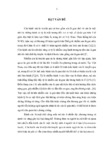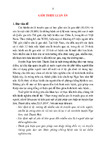
Please use this identifier to cite or link to this item:
http://dulieuso.hmu.edu.vn/handle/hmu/2246| Title: | Thực trạng nhiễm sán lá truyền qua cá trên người, yếu tố liên quan và hiệu quả một số giải pháp can thiệp tại huyện Nga sơn, Thanh Hóa năm 2013-2014 |
| Authors: | Ngọ Văn, Thanh |
| Advisor: | TS. Vũ Hồng, Cương GS.TS. Nguyễn Văn, Đề |
| Keywords: | 62720115;Vi sinh y học |
| Issue Date: | 2016 |
| Abstract: | THÔNG TIN TÓM TẮT NHỮNG KẾT LUẬN MỚI CỦA LUẬN ÁN TIẾN SĨ Tên đề tài: Thực trạng nhiễm sán lá truyền qua cá trên người, yếu tố liên quan và hiệu quả một số giải pháp can thiệp tại huyện Nga sơn, Thanh Hóa năm 2013-2014 Mã số: 62720116 ; Chuyên ngành: Ký sinh trùng Nghiên cứu sinh: Ngọ Văn Thanh Người hướng dẫn: 1. TS. Vũ Hồng Cương; 2. GS.TS. Nguyễn Văn Đề Cơ sở đào tạo: Trường Đại học Y Hà Nội Những kết luận mới của luận án: 1. Tỷ lệ, cường độ nhiễm sán lá ở người, ấu trùng ở cá và loài sán lá tại 4 xã nghiên cứu - Tỷ lệ nhiễm sán chung của 4 xã là 14,5%. Trong đó xã Nga Thái có tỷ lệ nhiễm SLRN (22,5%) và nhiễm chung (25,5%) là cao nhất. - Nam giới có tỷ lệ nhiễm sán chung, nhiễm SLGN, SLRN và nhiễm phối hợp đều cao hơn nữ giới. - Độ tuổi từ 30 - 59 có tỷ lệ, cường độ nhiễm sán cao hơn nhóm tuổi dưới 30 và trên 60. - Người làm ruộng, người làm các nghề khác có tỷ lệ, cường độ nhiễm sán lá cao hơn Cán bộ viên chức - Hưu trí và học sinh. - Cường độ nhiễm sán lá của cả 4 xã điều tra đều ở mức nhiễm nhẹ. - Tỷ lệ nhiễm ấu trùng sán lá trên cá là: 11,6%, cá mè nhiễm cao nhất (18,0%), cường độ nhiễm 3,6 ấu trùng/1 cá xét nghiệm. - Loài sán lá được xác định tại các điểm nghiên cứu là: Clonorchis sinensis, Haplorchis taichui và Haplorchis pumilio. 2. Yếu tố liên quan đến tỷ lệ, cường độ nhiễm sán lá Nhóm người đã từng ăn gỏi cá nước ngọt có nguy cơ nhiễm sán lá cao gấp 23,019 lần nhóm người chưa từng ăn gỏi cá. 3. Hiệu quả điều trị bằng praziquantel và can thiệp truyền thông giáo dục sức khỏe cộng đồng phòng chống bệnh sán lá tại điểm nghiên cứu - Tỷ lệ sạch trứng sau điều trị từ 96,0% đến 96,9%, tỷ lệ giảm trứng là 100%. - Tỷ lệ tái nhiễm ở nhóm không can thiệp (14,58% ), cao hơn nhóm can thiệp (3,13 % ); Còn tỷ lệ nhiễm mới cũng tương tự (1,14 % so với 0,3%). - Tỷ lệ, cường độ nhiễm sán của nhóm can thiệp giảm hơn nhóm không can thiệp (tỷ lệ 87,9% so với 50%), cường độ giảm 89,9% so với 58,7%. - Tỷ lệ người dân ăn gỏi cá ở nhóm can thiệp giảm 75,8%, so với nhóm chứng chỉ giảm 3,4%. - Kiến thức, hiểu biết và các hành vi liên quan đến phòng chống bệnh sán lá ở nhóm can thiệp truyền thông đều được cải thiện đáng kể. NGƯỜI HƯỚNG DẪN GS.TS. Nguyễn Văn Đề Hà nội, ngày 27/6/2016 NGHIÊN CỨU SINH Ngọ Văn Thanh SUMMARY OF NEW CONCLUSIONS OF DOCTORAL DISSERTATION. Dissertation title: The current state of fish-borne trematodes, involved factors and effectiveness of intervention in Nga Son district, Thanh Hoa province 2013-2014 . Code: 62720116; Specialization: Parasitology. Research student: Ngo Van Thanh. Instructors: 1. Dr. Vu Hong Cuong; 2. Prof. Nguyen Van De. Institute: Hanoi Medical University. Conclusions of the dissertation:. 1. The rate and intensity of infection fluke in humans, in fish and flukes in 4 commune studies. - General fluke infection rate was 14.5% of the 4 communes. In which the Nga Thai commune’s small intestinal flukes prevalence (22.5%) and general infection (25.5%) is the highest.. - Men have general fluke infection rate, infection small liver fluke, small intestinal fluke and mixed infections were higher than women.. - By ages 30-59 ratio, the higher the intensity of parasitic infections age groups under 30 and over 60.. - The farmer, who do other jobs ratio, intensity higher fluke infection Personnel officer - Retirement and students.. - Trematode infection intensity of the 4 communes surveyed at a slightinfection.. - Prevalence of larval trematodes in fish are: 11.6%, the highest infected H. molitrix (18.0%), infection intensity of 3.6 metacercariae / 1 fish muscle.. - Fluke is determined at the point of the study is: Clonorchis sinensis, Haplorchis taichui and Haplorchis pumilio. 2. Factors relating to the rate and intensity of fluke infection . Groups who have eating raw freshwater fish have higher risk than 23.019 times fluke groups never eat raw fish.. 3. Effective treatment with praziquantel and media intervention community health education fluke disease prevention at the study site:. - Clean egg ratio after treatment from 96.0% to 96.9%, the ratio is 100% egg reduction.. - Reinfection rate in the intervention group (14.58%), higher than the intervention group (3.13%); While new infection rates were similar (1.14% versus 0.3%).. - The rate and intensity of tapeworm infection reduction intervention group than non-intervention group (87.9% and 50%), intensity (89.9% and 58.7%).. - The proportion of people eating raw fish in the intervention group decreased 75.8%, compared with the control group decreased by 3.4% only.. - Knowledge, understanding and behaviors related fluke disease prevention in the intervention group communications are improved significantly Instructors Prof. Nguyen Van De Ha Noi, the 27th, june 2016 Research student Ngo Van Thanh . |
| URI: | http://dulieuso.hmu.edu.vn//handle/hmu/2246 |
| Appears in Collections: | Luận án (nghiên cứu sinh) |
Files in This Item:
| File | Description | Size | Format | |
|---|---|---|---|---|
| 188_NGOVANTHANH-LA.pdf Restricted Access | 3.63 MB | Adobe PDF |  Sign in to read | |
| 188_NgoVanThanh-tt.pdf Restricted Access | 749.91 kB | Adobe PDF |  Sign in to read |
Items in DSpace are protected by copyright, with all rights reserved, unless otherwise indicated.